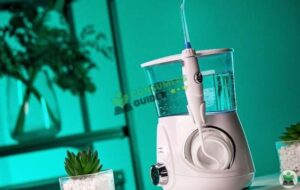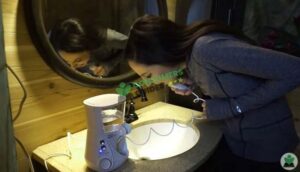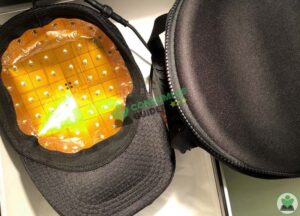Keeping things away from your pool water whether they are ducks or contamination is a big responsibility of pool owners. And, in order to sanitize and clean the pool, introducing Chlorine to the pool would be the best option.
A good quantity of Chlorine added in the pool will sanitize and disinfect the pool water. It also acts as an oxidizer (to treat harmful pollutants). However, adding too much Chlorine can cause red swollen eyes and can damage the swim suit as well.
Adding the appropriate amount of Chlorine with respect to your pool size and adding it correctly is very important. Don’t worry, we will guide you in detail about how to add and how often you should add the Chlorine.
So, let’s dive in…!
Types of Chlorine for Pools
When it comes to Chlorine for pools, there are five types of Chlorines which you can use to disinfect and clean the pool;
- Powder (Calcium Hypochlorite)
- Liquid (Sodium Hypochlorite)
- Tablets (Trichlor)
- Dichlor
- Lithium hypochlorite
Let us give you a brief introduction about each.
If we talk about Calcium hypochlorite (powdered Chlorine), it is 60 to 75% concentrated with Chlorine and is considered as the strong oxidizer. Also, it is mostly used in pools to increase the Calcium levels.
In addition, this Chlorine has a pH of 12 so when you are adding it, make sure to add any acid as well to maintain the pH of the pool.
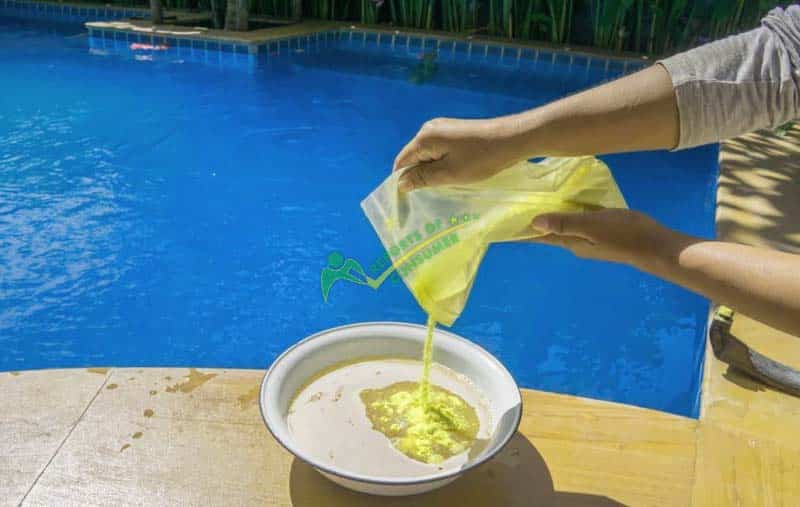
Liquid bleach or Sodium Hypochlorite is being used widely for commercial and home pools. This type has been used for centuries now and still most people prefer to go for this option as it is an inexpensive option and sanitizes the water quite efficiently.
Since this Chlorine solution is diluted, adding it in bulk wouldn’t affect the pool chemistry much (that doesn’t mean you need to add it in bulk, we will guide you how to add it though).
However, it’s pH is 12 and we would recommend you to add muriatic acid after adding it to balance the pH and alkalinity level of the water.
PRO TIP: It would be best to store the liquid Chlorine bleach in a cold and dry place.
Next comes the Trichlor tablets which are mostly used in private pools. These tablets take time to dissolve in water but are highly reactive (90% Chlorine ). The sanitation and cleaning the water would be very efficiently done but the pH of these tablets are 3.
So, when using these, make sure to use pH accelerators as well to maintain the water chemistry.
You may also like: Ways to increase the pH of a Pool
Dichlors are in powdered form and are the most stable pool Chlorine . Adding it in the pools is easy (it dissolves a bit fast) as they are in powdered form.
Also, it is best for both sanitizing and shocking the pool. The pH is around 7 and you would be needing a little amount of pH increaser or decreaser after adding it (depending upon the pH after adding it). These are a bit expensive though.
Lastly, the Lithium hypochlorite is granular Chlorine (Unstabilized) and is excellent to use for shocking the pool. It dissolves in the water very quickly unlike other forms but is very expensive.
This granular Chlorine is recommended for fiberglass and vinyl pool liner pools. It doesn’t contain any cyanuric acid unlike Trichlor and Dichlor tablets.

Unstabilized vs Stable Chlorine
The Unstabilized Chlorine is in its purest form with no additive. Whereas, the stable Chlorine comes with an additive like cyanuric acid, which prevents it from breakdown when it is exposed to the sunlight.
IMPORTANT NOTE: Don’t mix any type of Chlorine with other types to use, it will have adverse effects on the pool water chemistry and the reaction might cause damage (harmful gas releases, etc.).
In our opinion, liquid Chlorines are good for regular use, granular ones (Lithium hypochlorite) are best for shocking the pool in order to kill bacteria and contaminants (if you have a high budget). Overall, Dichlor Chlorines are the best option as they can sanitize and shock the pool quite efficiently.
SIDE NOTE: Chlorine tablets are slow to dissolve in water as compared to the powdered ones. So choose according to your preference.
How much Chlorine to Add in a Pool?
It is important to know that how much Chlorine is good for your pool as excess amounts can have a negative impact on the swimmers. Amount of Chlorine depends upon the size and capacity of your pool; how much water your pool can hold.
The general recommended value of Chlorine in pools ranges from 1ppm to 3ppm (per gallon of water). In order to add the Chlorine in the pool, you need to calculate the volume of the pool (in gallons).
And, to make it easy for your, here are the formulas to find the volume with respect to the pool shapes;
- For rectangular pools = V= L x H x W x 7.5 (in gallons)
- For round pools = L x H x W x 5.9
- For oval shaped pools = L x H x W x 6.7
With the help of these formulas, you will be able to find the volume of your pool in gallons. 0.00013 ounces of Chlorine must be added in one gallon of water.
So, multiply the calculated volume (in gallons) with 0.00013 ounces. The answer would be the quantity to add in your pool.
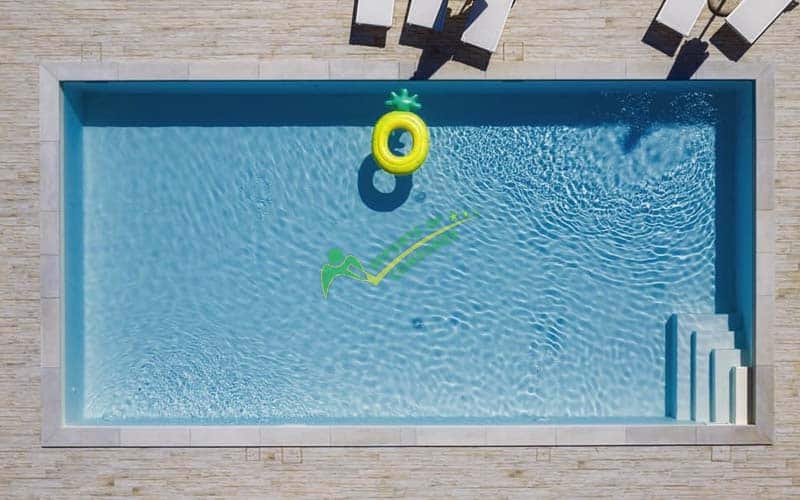
How often should we Add Chlorine in our Pools?
Well, in order to clean and sanitize your pool, it is recommended to balance the chlorine level in the pool from 2 to 3ppm for the first time. If you are adding the Chlorine for the first time, the free level Chlorine must be around 2 to 3ppm.
To make it easier for you, add 4 pounds (64 ounces) of Chlorine in 10,000 gallons of pool water for the first time.
Daily
If you use a pool daily then it is important to validate the Chlorine level. And, you shouldn’t add Chlorine everyday in your pool. Just keep checking if the Chlorine level is around 1 to 3ppm, if not, then add accordingly.
PRO TIP: Addition of 0.00013 ounces of Chlorine in one gallon of water increases the chlorine level by 1ppm. So, add accordingly to balance the level.
Weekly
Weekly addition of Chlorine is done to shock the pool in order to kill the bacteria and harmful contaminants in the pool water. It is necessary and recommended to shock the pool once every two week.
All of this is also important before winterizing a Pool.
As granular or tablet chlorine is used for shocking the pool, add around 1 gallon for 10,000 gallons of water.
For tablets, add one tablet per 5000 gallons of water.
Recommended Read: Best & Easy Way to Drain an Above Ground Pool
Steps to Add Liquid Chlorine to the Pool
Now that you have a proper idea about how much Chlorine is added and how often, let us tell you the procedure now.
The below method is also applied when adding powdered form Chlorine (it would be best to dilute them first for high efficiency).
Step 1: Test the Pool Water
There are multiple Chlorine test kits available in the market to check the Chlorine level in the pool.
This step is compulsory to take no matter what method you choose to add the Chlorine (we will explain the different methods as well).

If the pool Chlorine level is less than 1ppm, then you need to add the Chlorine to sanitize your pool and disinfect it.
Step 2: Add Chlorine
As far as the addition of liquid Chlorine, adding it is the simplest, just add the appropriate amount (as per the calculation which we have mentioned in detail above) and add it around the perimeter of the pool slowly.
Step 3: Mix the Water
After that, turn on the water pump to let it mix thoroughly in the pool. However, be cautious when adding the Chlorine and wear protective gear while doing it.
How to add Chlorine Tablets in the Pool?
Adding Chlorine tablets directly into your pool is not an efficient method as they take time to dissolve in water and sometimes they get dissolved in one place which discolors the pools (vinyl liners).
And for that, there are other options as well to add the Chlorine tablets and Chlorine in granular form.
Methods to add Chlorine Tablet in Pool
Here are some methods which you can opt for when adding Chlorine tablets or granular Chlorine.
- Chlorine floater
Chlorine floater dispensers are made up of plastic and float on the pool surface. These would be good for dispersing the Chlorine tablets in in-ground pools and this method is not recommended for above ground pools.
The reason is, most of the above ground pools have vinyl pool liners and these dispensers sometimes get stuck in one corner, which will eventually affect the pool liner.
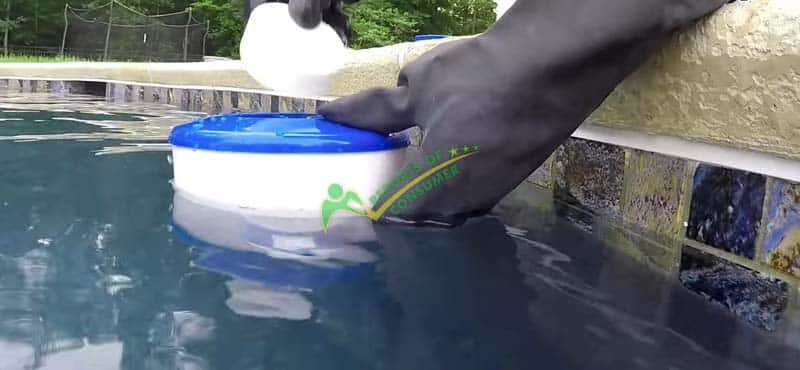
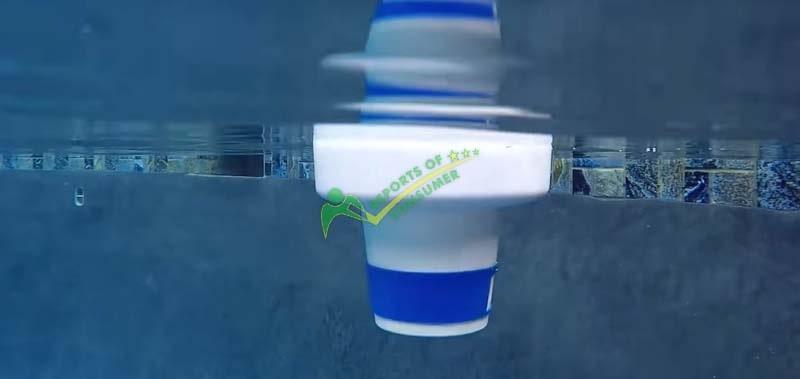
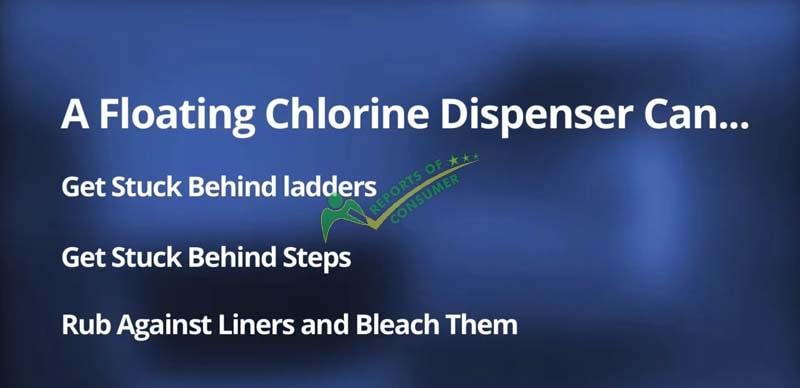
- Pool skimmer
Another method to add Chlorine tablets is by adding them directly in the pool skimmer and when you run the pool pump, the tablets will get dissolved in the skimmer basket and will further get injected in the pool.
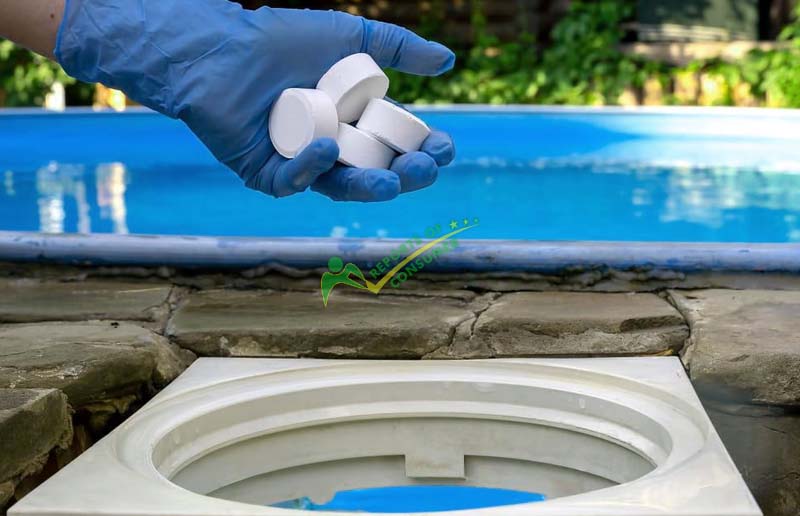
However, the drawback of this method is, if you are not running the water pump, the tablets will still continue dissolving which can corrode the water.
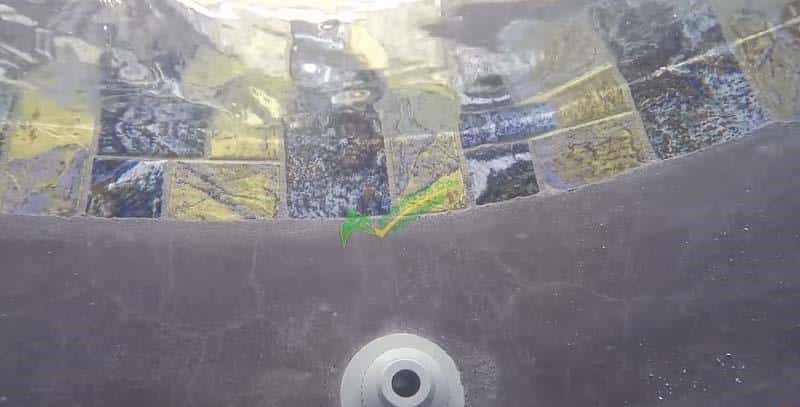
- Chlorinator
In our opinion, automatic pool chlorinators work best when you are adding tablets or granular Chlorine but at the same time, they are a bit expensive.
Set the setting on the chlorinator to balance the Chlorine levels from 1 to 3ppm and the rest is up to it.
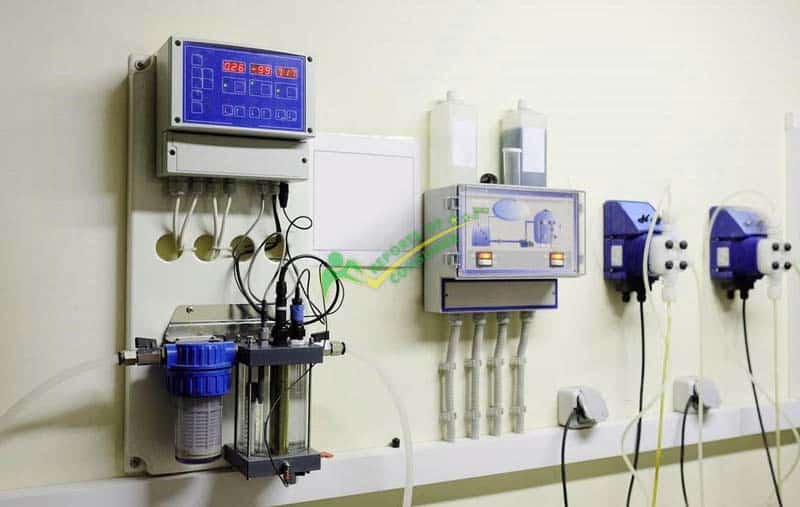
Side Note: If you are planning for a new above ground pool or anyone else, then you can also check our simple to follow guide on Installing an Above Ground Pool.
FAQs
How much Chlorine to add to the Pool per liter?
For every 1000 liters of water, add 4 grams of Chlorine and for 1 liter, add 0.004 gm.
What is the best method to add Chlorine?
The best method (whichever type you use) is to dilute the Chlorine and then add it in the water slowly.
Which is the best Chlorine to add in the Pool?
The best Chlorine is trichlor and dichlor which is best for both; to sanitize and shock the pool.
You may like: Finding and Fixing the crack and leak in an Above Ground Pool
Wrapping Up
Well, we hope your all confusions regarding this topic are clear now. It would be best to dilute the Chlorine before adding as this chemical is hazardous to deal with. For tablets, automatic chlorinators would be the best option.
However, easiest way to add Chlorine is to use the 3″ size Chlorine tablets for the pool.
Furthermore, always check the Chlorine level before addition and add accordingly to balance the level (1ppm to 3ppm).
Also, there is no need to add Chlorine on a daily basis as it will contaminate the pool rather than cleaning it. Once every two week is recommended though or add it when the levels are not balanced.
That would be all from our side and if you want to ask something, feel free to ask.

